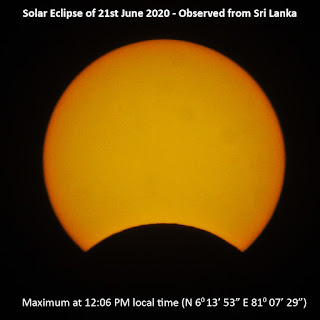When I covered the 21st June solar eclipse, I took 19 photos over roughly 3 hours to create a montage of Moon's path across the disc of the Sun. There were some private queries on how it was done, so I figured might as well explain it all in a post.
The shoot - Date, time and location:
Selecting a date and time for an astronomical event is not that hard. Except for a few events like a meteor shower or a comet, most of the astronomical events are set for very specific dates and times. Some like solar eclipses are very specific to a location as well.
For general astronomical events, you can check out websites like:
- https://eclipse.gsfc.nasa.gov/SKYCAL/SKYCAL.html
- http://www.seasky.org/astronomy/astronomy-calendar-2020.html
For comets:
- http://www.cometwatch.co.uk/current-observable-comets/
But my go to place for eclipses is:
- Fred Espenak's http://www.eclipsewise.com/. Not only does this show you past eclipses running for a few decades back and the current ones, it also shows you the eclipses for the next few decades. In case you want to travel to catch the next total solar eclipse, you've got all the info you need here ;)
 |
| Eclipse Path - 21 Jun 2020 - eclipsewise.com |
Using the maps provided at eclipsewise.com, I quickly identified that it does not matter where exactly I am in Sri Lanka, I will only see a partial eclipse. But still, your exact location matters. If I was in the northern end of the country, I would've seen roughly a 2 times more obscuration of the Sun than I saw from the location I picked in the southern part.
The biggest problem when it comes to astronomical observations is the weather. There is a popular astrophotographer's joke that more inclined you are to observe an astronomical event and the more expensive your equipment is, more likely you are to attract clouds.
My first plan of action once the the eclipse path was found out was to find a location that is likely to give me a reasonably cloud free area in the country. This is where the choice of going south came in. From where I live, the southern side of the country can be accessed at most in four to five hours whereas the northern part of the country needs about eight hours. At the expense of a lower intensity event, I chose a more predictable location (weather predictions are way more accurate within a few hours than half a day).
Photographing the Sun
Taking photos of the Sun is not that difficult, but it needs to be done with the correct filter. With incorrect set ups, you can not only completely decommission your camera, but also become permanently blind.
A camera works by focusing light through a lens to a single point. Some of you may remember the experiments you did as a child with a hand lens and a piece of paper (where the paper caught fire). The mechanics of a camera follows exactly that. Unless you have a proper filter, the heat could destroy the optical sensors in the camera. In case you were going to look through the eyepiece of the camera, that could completely blind you.
I used my Canon 550D with the 70-300mm telephoto lens for the shoot. I have my own solar filter that is made out of a fully exposed x-ray film, I would not however recommend anyone else to use that. A friend of mine was able to use an ND filter under cloudy weather to take a few good photos of the sun, but no ND filter can beat a proper solar filter.
Before I went out shooting on the eclipse day, I tried shooting with the filter to figure out the optimal configuration. I soon found out that even with my filter, a bright source such as the Sun requires a setting of F20 aperture, 1/800s shutter speed at 100 ISO. That is a good setting however, given that I was going to be shooting hand held as opposed to on a mount. A shutter speed of 1/800s would mean that there will be barely any camera shake. This doesn't mean that you can always shoot at the same setting throughout though. Depending on the clouds at very high altitude, they can act as filters and can change even through the time of the eclipse shoot. You would need to pay some attention to the actual exposure readings that your camera shows and figure out the minute changes yourself.
From that point on wards, it was was a simple matter of waiting. For 3 hours ;)
But, of course this is just the first part. Stay tuned to find out how I created the montage and had to figure out the path of the moon in my next post!

Comments
Post a Comment